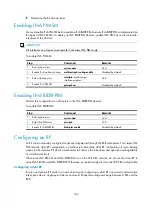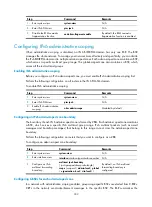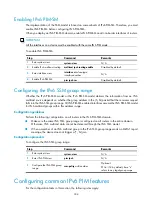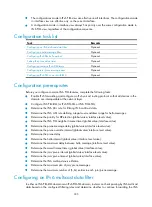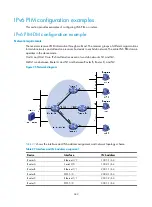
327
In IPv6 BIDIR-PIM, a static RP can be specified with a virtual IPv6 address. For example, if the IPv6
addresses of the interfaces at the two ends of a link are 1001::1/64 and 1001::2/64, you can specify a
virtual IPv6 address, like 1001::100/64, for the static RP. As a result, the link becomes an RPL.
To make a static RP to work correctly, you must perform this configuration on all routers in the IPv6
BIDIR-PIM domain and specify the same RP address.
To configure a static RP:
Step Command
Remarks
1.
Enter system view.
system-view
N/A
2.
Enter IPv6 PIM view.
pim ipv6
N/A
3.
Configure a static RP for IPv6
BIDIR-PIM.
static-rp
ipv6-rp-address
[
acl6-number
] [
preferred
]
bidir
No static RP by default.
Configuring a C-RP
In an IPv6 BIDIR-PIM domain, you can configure routers that intend to become the RP as C-RPs. The BSR
collects the C-RP information by receiving the C-RP-Adv messages from C-RPs or auto-RP announcements
from other routers. It organizes the information into an RP-set, which is flooded throughout the entire
network. Then, the other routers in the network calculate the mappings between specific group ranges
and the corresponding RPs based on the RP-set. HP recommends that you configure C-RPs on backbone
routers.
To guard against C-RP spoofing, configure a legal C-RP address range and the range of multicast groups
to be served on the BSR. In addition, because every C-BSR has a chance to become the BSR, you must
configure the same filtering policy on all C-BSRs in the IPv6 BIDIR-PIM domain.
When configuring a C-RP, ensure a relatively large bandwidth between this C-RP and the other devices
in the IPv6 BIDIR-PIM domain.
To configure a C-RP:
Step Command
Remarks
1.
Enter system view.
system-view
N/A
2.
Enter IPv6 PIM view.
pim ipv6
N/A
3.
Configure an interface to be a
C-RP for IPv6 BIDIR-PIM.
c-rp
ipv6-address
[
{
group-policy
acl6-number
|
scope
scope-id
} |
priority
priority
|
holdtime
hold-interval
|
advertisement-interval
adv-interval
] *
bidir
No C-RP is configured by
default.
Enabling embedded RP
With the embedded RP feature enabled, the router can resolve the RP address directly from the IPv6
multicast group address of an IPv6 multicast packets. This RP can replace the statically configured RP or
the RP dynamically calculated based on the BSR mechanism. Thus, the DR does not need to know the RP
address beforehand.
The default embedded RP address scopes are FF7x::/12 and FFFx::/12, where x refers to any legal
address scope. For more information about the Scope field, see "Multicast overview."
Perform this configuration on all routers in the IPv6 BIDIR-PIM domain.














